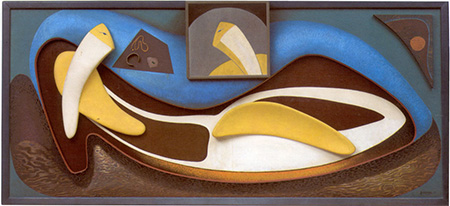
The Frye Art Museum's current "Archipenko: A Modern Legacy" has particular cogency on the West Coast. Not only did the Ukrainian artist spend time in Los Angeles, he also taught at the University of Washington in Seattle in 1935, 1936 and 1951, where his influence was considerable. Arriving in the U.S. in 1923 with an American wife, sculptor Angelica Forster, he traveled the country widely over the ensuing 40 years, cementing his reputation as a premier cubist sculptor, pedagogue in his private schools, and, later, rediscovered modern master. Alexander Archipenko (1887-1964) is best known for having a "strong claim as a pioneer cubist sculptor," as Norbert Lynton put it, because of his innovation of the hole, or negative space, as a key formal element, his incorporation of cubist collage methods into sculpture, and his pursuit of new materials such as tin, aluminum, zinc, Plexiglas, sheet metal, lead, copper, lighting and, crucially for the West Coast, ceramics. Who knew that Archipenko was the godfather of West Coast ceramics prior to Peter Voulkos?
The artist's early masterpieces are on view, although several of them are posthumous reconstructions, unlike the earlier surveys in New York and elsewhere that drew upon originals in prestigious East Coast art museum collections. Of the 37 three-dimensional works on view, five are posthumous, including the famous "Queen of Sheba" (1961/1989), and nine of them are painted or unpainted earthenware. This mixture puts a different slant on the artist's oeuvre, suggesting that America unleashed additional innovations after his 1923 arrival and subsequent establishment of private schools in New York, Los Angeles, San Francisco and Chicago, some of which continued until his death in 1964. His exhibition at the Chicago World's Fair in 1933 was the high point of his American career.
Born in Kiev and trained there as an artist, he soon moved to Moscow where he met Malevich and other nascent revolutionary artists. In Paris he became part of the legendary Golden Mean group with Picasso and others. Then on to Berlin, where he was heralded as a greater cubist sculptor than Picasso. And finally to New York, where he had long since had a stupendous impact in the 1913 Armory Show. The considerable interest in his work beyond France led to the honor of the biggest show at the 1920 Venice Biennale. His reputation as a leading modernist and eyewitness to the revolution seemed secure. Why, then, did he leave Europe?
When living in Berlin with Forster, both determined that economic conditions in Europe were such that going to the U.S. would be a shrewd move. At first, it seemed that it was. However, as another art historian pointed out, the downside was that his work "generally lost its brilliance but he did not cease to experiment with processes and materials, including forms of translucent plastic, lit internally." Eminent critic and art historian Peter Selz, now 97, noted how Archipenko's "tendency toward a colder or more mysterious mode of expression was sometimes counterbalanced by the use of polychrome." This is the interface with the rise of West Coast ceramic sculpture. Selz recently added in an interview, "What he did in America was an echo of what he had done. When they were all young, they did their best work. He was cut off from his friends [Lipchitz, Laurens, and Picasso]."
Nevertheless, as this exhibition underscores, by 1920 Archipenko was regarded by many as the most important sculptor of his era, actually ahead of Picasso in terms of recognition outside Paris. We see the birth of figurative cubist sculpture in the early galleries at the Frye, in such familiar works from art-history textbooks as "Dance" (1912/59), "Boxing" (1914/64), "White Torso" (1916/50) and "Flat Torso" (1914/54). The winding or contrapposto position of the female intensifies the sense of dynamic movement through space. "Walking" (1912/68) is a good example of the use of negative space the artist pioneered: its center core is the figure's body.
Given the use of posthumous casts and the heavy representation of post-World War II works, the ceramic sculptures of the 1925-45 period are stand-outs with their beautifully colored surfaces, linear incisions to simulate fabric or leather, and revealing poses. "Young Girl" and "The Bride" (both 1936) are sleek and streamlined, like the period's decorative arts style. The latter is in the Seattle Art Museum collection, purchased after one of the UW residencies and possibly made on campus. "Woman in Fur" (1936) is more entertaining, a strip-tease of a pulled-back mink coat revealing a kneeling, naked body. The warm, orange-painted tones on the body communicate sexual allure. "Seated Figure" (1938) is more highly abstracted, replete with blue holes and soft brown skin. "Tartar Woman" and "Spanish Woman" (both 1942) toy with ethnic costumes, as does "Arabian" (1936) which includes a complete body veil. While the latter is painted aluminum, it continues the surface decoration of the clay pieces.
It's still a pleasure to see the later works, if only because they complete the picture of an artist somewhat underknown for his entire body of work. The 1950 aluminum casting of "Torso in Space" (1935) looks remarkably modern, almost aeronautic and space-age. It joins other postwar works like "Queen" (1954), "Revolving Figure" (1956—with an electric motor), and "Cleopatra" (1957). His final masterpiece, the schematic queen of the Nile is presented with cosmetics, mirror, and blue river backdrop. Formally brilliant and definitely using then unconventional materials such as Bakelite and plywood, "Cleopatra" affirms most critics' judgments against the vitality of the last works, approving Archipenko's significant early innovations but, with its flat, drab colors and aging, period look, out of kilter with the gestural expressionism of the era. It is the polychromes, the low-relief sculptural aspects, and the ceramics that will attract interest in the future for this heretofore overlooked West Coast artist.
